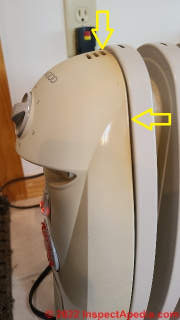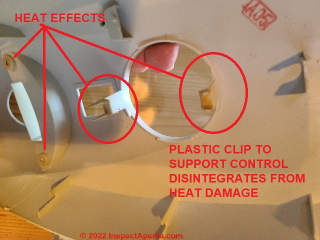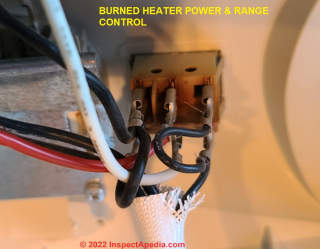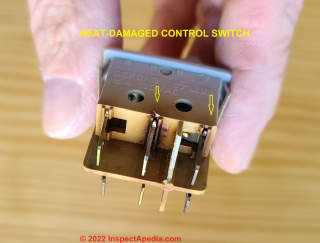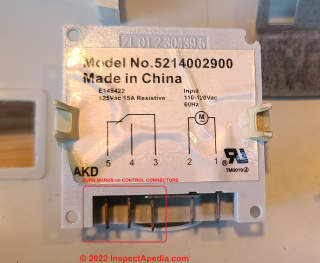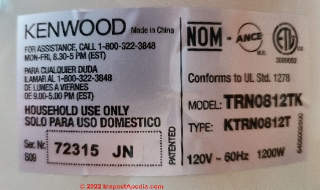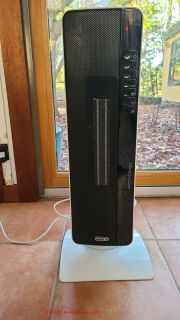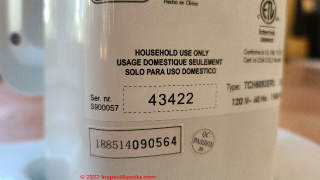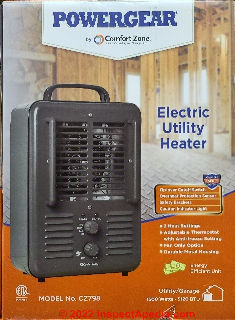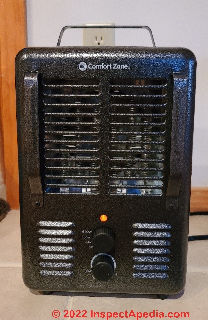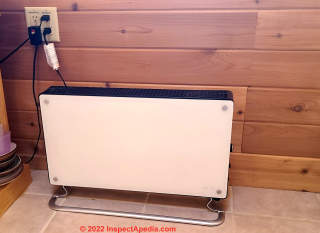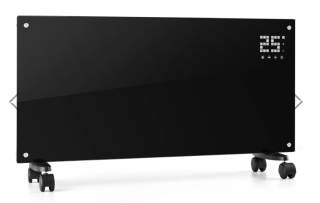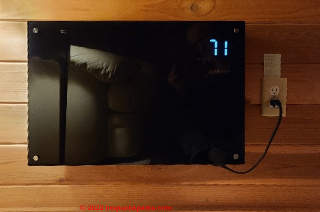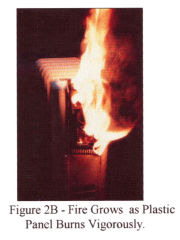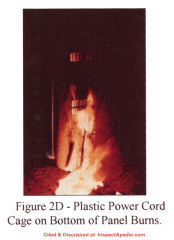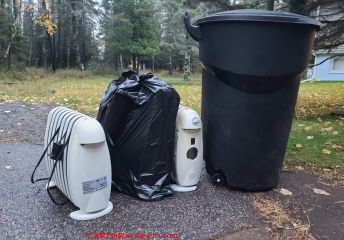 Portable Electric Heaters
Portable Electric Heaters
Failures, Fire-Hazards, Safety
- POST a QUESTION or COMMENT about portable electric heaters and electric heater problem diagnosis & repair
Portable electric heaters: examples of failures, dangers of combustible plastic, failure of heater controls and plastic parts.
This article series describes the types of residential electric heating systems and their inspection, diagnosis & repair.
We describe each type of electric heat used in buildings and provide links to further and more detailed electric heat diagnosis & repair articles for each heater type.
InspectAPedia tolerates no conflicts of interest. We have no relationship with advertisers, products, or services discussed at this website.
- Daniel Friedman, Publisher/Editor/Author - See WHO ARE WE?
Portable Electric Heater Overheat & Risk of Fire
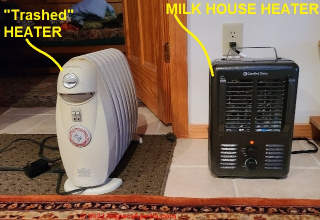 Here we describe and illustrate overheated, damaged plastic parts in portable electric heaters. As Dr. Aronstein [cited below] points out, combustible plastic parts used in many modern appliances are a serious fire hazard.
Here we describe and illustrate overheated, damaged plastic parts in portable electric heaters. As Dr. Aronstein [cited below] points out, combustible plastic parts used in many modern appliances are a serious fire hazard.
Photo: The now-trashed electric heater that we disassembled, examined, and whose troubles we document on this page is the white one in the photo at left.
[Click to enlarge any image]
Unlike Aronstein, who is not afraid to let an electrical device catch fire during testing by an expert (see Electro-Kindling cited below), after seeing signs of serious overheating at the two heaters shown at the top of this page, rather than plug them in and wait to see them catch fire, we put these heaters out with the trash.
Two of the heaters shown at left in our photo and in use in northern Minnesota were replaced with what we believe to be a safer portable electric heater alternative: heaters that use all-metal parts, such as milk-house heaters and other all-metal heaters illustrated on this page.
There are several all-metal or nearly-all-metal portable electric heater types and brands as we illustrate and discuss below. In our OPINION and citing research in this article, portable heaters that avoid use of plastic parts, certainly combustible plastic parts, are safer than others.
First signs of trouble at an electric heater
The portable electric heater whose overheating, demise, and disassembly are illustrated here, had been in intermittent use in northern Minnesota for about six years.
- Buzzing noises from the timer control - probably a failing timer motor
- Brown discoloration of plastic heater parts on the outside of the heater
Signs of trouble inside the heater, found by disassembly included
Above: plastic cast parts integral with the shell of this heater and intended to hold controls in place were so deteriorated by heat that they disintegrated on the least disturbance.
- Burnt, fragile, crumbly plastic supports of the heater's controls (shown above)
- More burnt paint suggesting the effects of heat on the heater's internal surfaces and parts
- Heat deteriorated insulators on electrical connectors were so fragile that they disintegrated at the slightest disturbance
 ...
...  ...
...
and a burned heat on-off-range control toggle switch (below)
...
We noted that the heater's internal electrical wires did not show signs of overheating or damage. The trouble centered on plastic parts.
Types of electric heater failures that may lead to unsafe conditions
- Prolonged heat exposure causes plastic heater parts holding a control or wire or other control to come loose from their mount, risking control failure, overheating
- Internal short circuit causes electrical arcing that sets plastic heater parts on fire
- Loose screws or parts that permit movement of a heater part that blocks the operation of a resistance-type electric heater's fan - heater overheats, plastic parts may catch fire
- Nominally self-extinguishing electrical wire insulation in the heater, supported by heat from other burning heater parts, burns causing short circuiting that melts or ignites other nearby combustible components (Aronstein 1996)
- Electric heater on-off timer failure: timer stops functioning, heater runs continuously instead of turning on-and off on schedule, risking overheating
- Electric heater thermostat or temperature control stops functioning, heater runs at uncontrolled heat level instead of turning off in response to room temperature, risk of overheating
Data tag for the heater illustrated above:
Not all Portable Electric Heaters Using Plastic Show Signs of Overheating
The DeLonghi Ceramic Tower Heater shown below has been in occasional use in a New York Home since about 2006 without showing signs of browned plastic or other overheating indicators like those on the heater discussed above on this page.
Like most of the portable electric heaters we've found, installed, tested, this one, DeLonghi model # TCH8093ERL, was also made in China.
From the DeLonghi heater's serial number shown above, 188514090564 and from examining the print date of the instructions provided with this heater (05/05/01) we think this heater was manufactured in 2005.
Portable Electric Heaters that use Fewer Plastic Components
It can be a bit of a challenge to find an inexpensive portable heater that seems safer for long-term use than the plastic-ridden model we show above.
In an informal survey of a large building supply store in Duluth MN (Menards) in October 2022, of about forty different portable heaters on display, there was only one that used pretty much all metal parts - shown just below.
However there are a number of better made, and more expensive, portable electric heaters available including models with little or no plastic (that might or might not be combustible - Ed.) as we will describe below.
Milk House Heaters - simple, probably more safe portable electric heaters
Above: the "milk house" style utility heater shown uses almost no plastic except for its control knobs. Sold at building suppliers, this portable electric heater was also very inexpensive: about $30. U.S. at Menards in Duluth, MN.
Features include a "freeze-protection" setting that turns on the heater when temperatures approach freezing, two heat ranges (we run it on 1300 Watt but it also has a 1500 Watt setting) and an adjustable thermostat that is impossible to read. (We taped a tiny bit of blue masking tape on the control knob to serve as a more-visible pointer). - source: comfortzoneproducts.com
Watch out: however this low-priced heater is also
- Noisier than its competitors: its fan is a bit noisy which makes us wonder about the fan motor's life expectancy. We'll update our opinion here after this heater has been in use for a year or so as we're testing two of them by use in cold weather.
- In our OPINION, cheaply made: thin light-weight metal. (Made in China)
Other portable or wall-mounted electric heaters to consider
Above: a (nearly) all-metal portable 1500 Watt infrared heater from Konwin: Konwin Infrared Zone Heater Model No. GD9315BCP-6.lb
- This heater's fan is very quiet and the heater enclosure, all metal, is heavier and feels like a more durable product than the milk-house heater described above.
The heater comes with a hand-held remote control that we do not use. - Produced by Intertek, and like the heater above, made in China, unlike some of its competitors, the manufacturer includes a human-legible manufacturing date code on the heater's data tag.
Service: EMail: Service@konwinchina.com
Portable Glass-Faced Electric Heater
The Mill heater shown above, Model SG1500GLASS, was attractive, used few plastic parts, and could be operated with or without its built-in circulating fan.
We tried this heater in the same northern Minnesota cabin as the others shown on this page. The heater worked well for three years, then in March 2021 it developed a rattle in its fan. The fan motor quickly died completely.
On contacting the U.S. vendor of this heater (Virtual Supply, Beaverton OR), we learned that it was purchased from an off-shore vendor, that it was no longer sold in the United States, and that no repair parts or repair service were available
The manufacturer, Mill International A.S., promptly refunded our purchase price (about $100. U.S.D) and this heater was discarded. Mill International stands behind their products, and similar heaters are still available in the U.S. and Europe.
Mill International AS, Grini Næringspark 10, 1361 Østerås, Norway Web: www.millheat.com
Portable OR Wall Mounted Electric Heater
The glass-fronted infra-red heater shown here as a wall-mounted unit is in use in the same building in northern Minnesota as the milkhouse heater discussed above.
Sold as a 2000W heater for about $130. U.S., this heater is sold in several sizes, wattages, and configurations including curved-front portable heater models and in prices from about $100. to $150 U.S.
The heater is sold with a wheel kit for use as a portable heater, or the wheels can be removed and a manufacturer-supplied bracket mounts the heater to a wall, as we've done below.
- High quality, glass front, metal body, no visible plastic parts, in use for five years without incident - date code 08/18
- A bit more difficult to find the heater's setting controls if you've not read the instructions: the controls disappear from the front display - you have to know to touch below the room temperature shown at upper right on the heater
- Klarstein's website www.klarstein.de shows a current version of this same heater https://www.klarstein.de/Heizen/Konvektorheizung/Bornholm-Konvektions-Heizgeraet-2000W-Timer-2-Heizstufen-ECO-Modus-Schwarz.html
For English speakers see https://www.klarstein.co.uk/ - The original packaging's label data provides a link that no longer offers the user's manual for this heater at use.berlin - we also checked berlin-brands-group.com - a brand marketing website, actual company unknown, this heater, too, is made in China.
Research on Portable Electric Heater Failures, Fires, Safety
- Adekunle, A., A. Asuquo, N. Essang, I. I. Umanah, K. E. Ibe, and Ayo Bamidele Alo. "Statistical analysis of electrical fire outbreaks in buildings: Case study of Lagos State, Nigeria." Journal of Sustainable Development Studies 9, no. 1 (2016).
Excerpt:
Portable electric space heaters are especially dangerous, … Any electrical appliance can start a fire if it makes contact with ... - Aronstein, J., P.E. Ph.D., ELECTRO KINDLING: Easily-Ignited Free-Burning Plastic Materials in Electrical Applications [PDF] (1996)
Excerpt:
The use of highly combustible plastics in the construction of today's electrical products is increasing. This is a major trend backward in fire safety. Minor electrical failures are more likely to cause serious fires when easily-ignited free-burning plastic materials are close at hand.
Fire and safety professionals should understand how easily these "electro-kindling" materials ignite and how vigorously they burn.
This article discusses several examples covering a broad range of electrical products. Older samples of most electrical items are made of non-combustible or self-extinguishing materials.
Today, many electrical products that used to simply "burn out" (become non-functional) on failure will now "burn up" (ignite) on failure because they are made with electro-kindling. - Illustrated above. - Brandyberry, Mark D., and George E. Apostolakis. "Fire risk in buildings: Frequency of exposure and physical model." Fire safety journal 17, no. 5 (1991): 339-361.
Excerpt:
... of alternative heating devices which are important to the occurrence of fires and deaths in residences in the US. These four heaters are portable electric heaters, portable kerosene ... - Brandyberry, M. D., and George E. Apostolakis. "Fire risk in buildings: Scenario definition and ignition frequency calculations." Fire safety journal 17, no. 5 (1991): 363-386.
Excerpt:
... of rectangular heaters to be considered are portable electric heaters and gas-fueled fixed-area heaters. There are a large variety of sizes and powers of these types of heaters, and … - Butturini, Randy P.E., FLUX MAPPING of RADIANT ELECTRIC HEATERS [PDF] (2005) U.S. CPSC,
Excerpts:
The U.S. Consumer Product Safety Commission (CPSC) staff reports that in 1999, electric heaters were associated with an estimated 4600 fire incidents 1 . Those incidents resulted in approximately 50 deaths, 290 injuries, and $109.8 million of property loss.
The cause of many of the incidents is reported to be heaters too close to combustible materials. Since air heaters do not raise a material’s surface temperature to its ignition point, it is possible that a significant portion of the incidents involved radiant electric heaters.
Radiant heaters possess characteristics that are different from other types of room heaters. While most fan-forced and natural-convection heaters create warm air, radiant heaters primarily generate infrared (IR) radiation. This radiation impinges on objects in front of the heater and warms their surfaces.
Heaters that create warm air cannot raise the temperature of an object in the air flow path above the exhaust temperature, typically between 100° and 200° Celsius. Radiant heaters transfer heat proportional to the 4th power of the absolute temperatures of the heat source and the heat sink.
The heating element of a radiant electric heater reaches temperatures of 100s of degrees Celsius.
The Underwriters Laboratories Inc. (UL) voluntary standards UL 1278 Movable and Wall-or Ceiling-Hung Electric Room Heaters, and UL 2021 Fixed and Location-Dedicated Electric Room Heaters, define a radiant heater as one with a “visibly glowing element,” whose visible portion attains a temperature of at least 650 °C (923 K).
No upper limit for heating element temperature is specified in the voluntary standards.
Element temperatures this high insure a high energy flux from the heater into its environment. Reflections from shiny surfaces behind the heating element add to the total flux impinging on an object in front.
Consequently, the possibility exists that common combustibles in proximity to a radiant heater can be heated to ignition. Air heaters avoid igniting combustibles in two ways. First, no commonly-found materials ignite at the air temperatures exhausted by the heater. Second, air itself possesses a low heat capacity and is not effective in transferring large amounts of energy onto objects.
Radiant energy transmission is capable of continuing to heat an object’s surface until its temperature approaches that of the heating element.
With ignition temperatures ranging from 233 °C for paper to 590 °C for wool 3 , there is the prospect for materials with high emissivities and high geometric view factors to absorb enough IR energy to ignite. - Butturini, Randy. FIXED-POSITION ELECTRIC HEATERS [PDF] (2002) Consumer product safety commission, United States of American (2002).
- Butturini, Randy, Final Report on Fixed-Position Electric Heaters, U.S. Consumer Product Safety Commission Directorate for Engineering Sciences, January 2002. http://www.cpsc.gov/library/foia/foia02/os/fpheater.PDF
- Campbell, Richard B. Home Fires Involving Heating Equipment. Quincy, Massachusetts: National Fire Protection Association, 2016.
- Faith, Nicholas. Blaze: the forensics of fire. Macmillan, 2000.
- Hosamani, Anand K., Bharat Naik, Shirish M. Kerur, Vinayak Ratan, Chandra Bhushan, L. Girisha, and Yash Anvekar. "Design and Development of Portable Electrical Resistance Furnace." In IOP Conference Series: Materials Science and Engineering, vol. 1065, no. 1, p. 012016. IOP Publishing, 2021.
- LaRue, Dean L., Fire Indicators, Engineering Project Report, U.S. Consumer Product Safety Commission, Directorate for Engineering Sciences, August 2002. http://www.cpsc.gov/LIBRARY/FOIA/FOIA03/os/fip2003.pdf
- Leff, Harvey S. "Kerosene vs. Electric Portable Heaters: The Question of Risk." Environment: Science and Policy for Sustainable Development 26, no. 2 (1984): 31-36.
Excerpt:
... The Electric Alternative Portable electric heaters with heat rates of up to 1.65 kW are readily … Electric heaters can pose fire hazards if they are placed near furnishings or draperies, ... - Krawiec, Edward, CP94-1 PETITION for DEVELOPMENT of a SAFETY SETANDARD for PORTABLE ELECTRIC HEATERS [PDF] (1995) U.S. CPSC
- Krawiec, Edward, PORTABLE ELECTRIC AIR HEATERS, Petition by Bernard Schwartz [PDF] (1994), U.S. CPSC. Summary of Meeting.
Excerpt: Ed Krawiec briefly explained that the purpose of the meeting was to review some of the details in the petition submitted by Mr. Bernard Schwartz concerning the risk of fire associated with portable electric air heaters.
SUPPLEMENTARY INFORMATION:
The Commission has docketed correspondence from Bernard A. Schwartz requesting development of a safety standard for portable electric heaters as a petition for rulemaking under provisions of the Consumer Product Safety Act (CPSA) (15 U.S.C. Sec. 2051 et seq.).
The petition asserts that portable electric heaters are associated with residential fires which result in a large number of deaths and injuries each year.
The petition describes the test apparatus, method, and criteria for a safety standard to eliminate or reduce the risk of death and injury associated with portable electric heaters. - U.S. Federal Register, - https://www.govinfo.gov/content/pkg/FR-1994-09-23/html/94-23490.htm - Krawiec, Edward W, Portable Electric Heaters, Engineering Project Report, September, 1987 U.S. Consumer Product Safety Commission.
- Miller, David, Smith, Michael, Green, Linda, 1999 Residential Fire Loss Estimates, U.S. Consumer Product Safety Commission, Directorate of Epidemiology, November, 2003 http://www.cpsc.gov/LIBRARY/fire99.pdf
- Scott, Lisa L., Fire Indicators Project Report, U.S., Consumer Product Safety Commission, Directorate for Laboratory Sciences, April, 2004.
- Swainson, Alexander, Colin Paterson, Pearse Doolin. AN INVESTIGATION INTO SUSTAINABLE HEATERS [PDF] (2015). University of British Columbia, Tutorial instructor, Dawn Mills, Ph.d.
Excerpt:
Heaters are mainly dangerous due to their ability to start fires since they achieve very high temperatures in order to heat a room. - Slegel, Louis. ELECTRIC AND OTHER TYPES OF HOUSE HEATING SYSTEMS [PDF] (1946) Oregon State College, Engineering Experiment Station
...
Continue reading at Xspan class="LI_Spaced"> PORTABLE ELECTRIC HEATER SAFETY or select a topic from the closely-related articles below, or see the complete ARTICLE INDEX.
Or see these
Recommended Articles
- DMMs VOMs SAFE USE OF - how to use VOMs and similar test equipment safely
- ELECTRIC HEAT - home
- ELECTRIC BASEBOARD HEAT SAFETY
- ELECTRIC HEAT CONTROLS - master list
- ELECTRIC HEAT BASEBOARD DIAGNOSE REPAIR - home
- ELECTRIC HEATER LOCATIONS
- ELECTRIC HEAT TYPES
- ELECTRIC HEATER RECALLS CADET & ENCORE
- NIGHT STORAGE HEATERS & HEAT SINK RADIATORS
- PORTABLE ELECTRIC HEATER FAILURES
- PORTABLE ELECTRIC HEATER SAFETY
- ELECTRICAL RESISTANCE vs HEAT GENERATED
- RADIANT HEAT MISTAKES - why were the occupants using electric heaters in this cabin in the first place?
- THERMOSTAT WIRING LINE VOLTAGE 120-208-240VAC - for electric heat
Suggested citation for this web page
PORTABLE ELECTRIC HEATER FAILURES at InspectApedia.com - online encyclopedia of building & environmental inspection, testing, diagnosis, repair, & problem prevention advice.
Or see this
INDEX to RELATED ARTICLES: ARTICLE INDEX to ELECTRIC HEAT
Or use the SEARCH BOX found below to Ask a Question or Search InspectApedia
Ask a Question or Search InspectApedia
Try the search box just below, or if you prefer, post a question or comment in the Comments box below and we will respond promptly.
Search the InspectApedia website
Note: appearance of your Comment below may be delayed: if your comment contains an image, photograph, web link, or text that looks to the software as if it might be a web link, your posting will appear after it has been approved by a moderator. Apologies for the delay.
Only one image can be added per comment but you can post as many comments, and therefore images, as you like.
You will not receive a notification when a response to your question has been posted.
Please bookmark this page to make it easy for you to check back for our response.
IF above you see "Comment Form is loading comments..." then COMMENT BOX - countable.ca / bawkbox.com IS NOT WORKING.
In any case you are welcome to send an email directly to us at InspectApedia.com at editor@inspectApedia.com
We'll reply to you directly. Please help us help you by noting, in your email, the URL of the InspectApedia page where you wanted to comment.
Citations & References
In addition to any citations in the article above, a full list is available on request.
- Fahrenheat produces a range of wall heaters including s 1500 heater often used in breezeways and baths, 2000 watt 240V wall units (Model#FFH1615) and commercial 4000 Watt 240V units such as the Model #VFK404. Farenheat products are sold by Marley Engineered products. Quoting from Marley:
Marley Engineered Products markets heating products under these well known name brands: Berko®, QMark®, Leading Edge®, Fahrenheat® and Marley Industrial Products®. Depending on brand, products are available for residential, commercial and industrial applications. - Marley Engineered Products, 470 Beauty Spot Road East, Bennettsville, SC 29510, Phone: 800-642-4328, Fax: 843-479-9932, Email: meptechsupport@marleymep.spx.com
- Dr. Jess Aronstein, protune@aol.com is a research consultant and an electrical engineer in Schenectady, NY. Dr. Aronstein provides forensic engineering services and independent laboratory testing for various agencies. Dr. Aronstein has published widely on and has designed and conducted tests on aluminum wiring failures, Federal Pacific Stab-Lok electrical equipment, and numerous electrical products and hazards.
Contact: J. AronsteinConsulting Engineer Bme, Msme, Ph.D., NYS. P.E. Lic. No. 39860, 909 Londonderry Ct., Schenectady, NY 12309 USA, Tel: (845) 462-6452 Email: AronsteinJesse@ieee.org - In addition to citations & references found in this article, see the research citations given at the end of the related articles found at our suggested
CONTINUE READING or RECOMMENDED ARTICLES.
- Carson, Dunlop & Associates Ltd., 120 Carlton Street Suite 407, Toronto ON M5A 4K2. Tel: (416) 964-9415 1-800-268-7070 Email: info@carsondunlop.com. Alan Carson is a past president of ASHI, the American Society of Home Inspectors.
Thanks to Alan Carson and Bob Dunlop, for permission for InspectAPedia to use text excerpts from The HOME REFERENCE BOOK - the Encyclopedia of Homes and to use illustrations from The ILLUSTRATED HOME .
Carson Dunlop Associates provides extensive home inspection education and report writing material. In gratitude we provide links to tsome Carson Dunlop Associates products and services.



